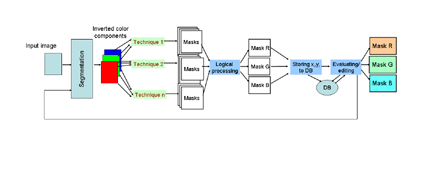Defects Detection
Taking into account the specificity of the triple colour photography technique, the following necessary condition for concidering an object in the image as a defect can be formulated: if an object in the colour image is a defect, it can be found only in one component of the tripplet. To reduce the error probability, the following rule is formulated.
Once
defect regions in different color components may be located
at the same spatial position and may overlap in the registered
colour image, a suspicious region should be considered as
a defect only if it is located in the same place in no more
than
two
images of the triplet. In other cases it will be considered
as a detail of a scene.
The main principles of the detection technique are as follows.
1. Detection of suspicious regions is performed separately in each component (R, G, B) of the registered color image. The exception is the group of defects (or artifacts) appeared as monochrome fragments. In this case the intensity values in all of the components are analyzed simultaneously.
2. A set of techniques is used for detecting local defects.
3. For detecting defects of a particular group a special technique can be applied.
4. Application of a particular technique results in a binary mask image.
5. Decision on labeling a suspicious region as a defect depends on the result of the analysis of three binary masks corresponding to three components.
6. For preserving historical authenticity of image content the resulting set of masks should be revised by an expert.
Finally,
a set of mask triplets should be obtained.
The developed procedure includes the follow-ing steps.
1. Segmenting image color compo-nents into a set of relatively homogeneous large regions (for example, sky, water surface, buildings, etc.).
2. For each of these regions in triple images a set of algorithms is applied sequentially for detecting defects of different groups. As a result, a set of mask triplets marking suspicious regions is obtained.
3. Composing resulting mask triplet using the rule formulated above.
4. Coordinates of found defect regions are recorded in the data-base for subsequent verification by experts. During verification, the false defect regions are removed from the masks.
The flowchart of the detection procedure:
Applied Techniques:
-
thresholding;
-
detecting regions of dominating chromaticity;
-
gradient-based technique;
-
second moment matrix technique;
-
morphological operations with nonflat structuring elements;
-
pixel-by-pixel classification.
| Home • Collection • Problem • Classification • Detection • Compensation• Examples • Biography • References |
